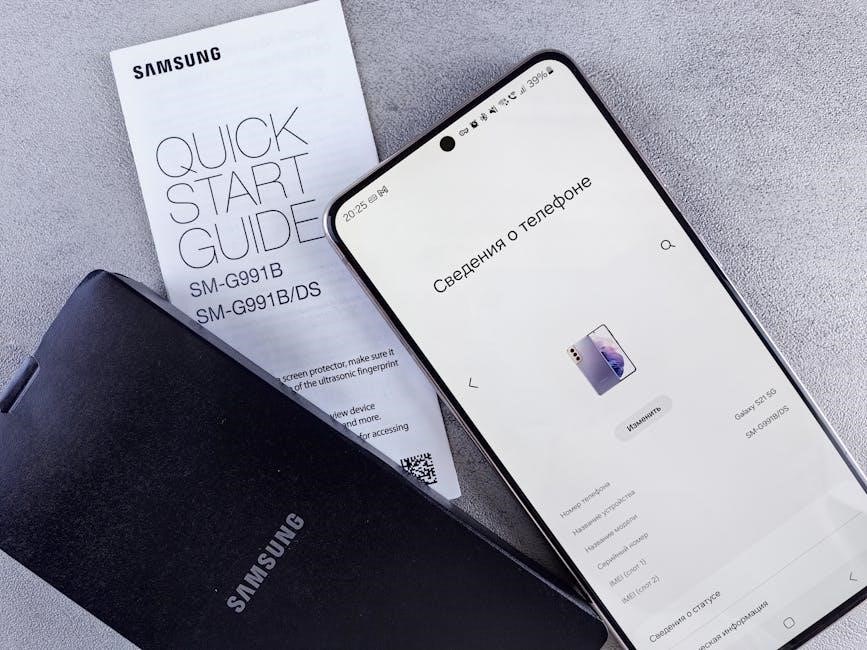
Welcome to the Spectra S2 Breast Pump‚ a powerful and intuitive electric breast pump designed for lactating women to express milk comfortably and efficiently. This manual provides comprehensive guidance on features‚ safety‚ and usage to ensure optimal performance and ease of use.

1.1 Key Features and Benefits
The Spectra S2 is a powerful‚ portable‚ and whisper-quiet electric breast pump designed for efficient milk expression. It offers customizable suction and speed settings‚ ensuring a comfortable and personalized experience. The pump features two operation modes: Massage Mode to stimulate letdown and Expression Mode for milk collection. Its compact design and rechargeable battery make it ideal for on-the-go use. The Spectra S2 is also BPA-free‚ ensuring safety for both mother and baby. With its advanced technology and user-friendly interface‚ this pump is a reliable choice for expressing milk comfortably and effectively‚ supporting breastfeeding journeys with confidence and convenience.
1.2 Importance of Reading the Manual
Reading the Spectra S2 User Manual is essential for safe and effective use of the breast pump. It provides detailed instructions on assembling‚ operating‚ and maintaining the pump‚ ensuring optimal performance. The manual outlines safety guidelines‚ such as contraindications and precautions‚ to prevent misuse and potential harm. Additionally‚ it offers troubleshooting tips for common issues‚ helping users resolve problems efficiently. By following the manual‚ you can maximize the pump’s lifespan and ensure hygiene standards are met. Understanding the features and proper usage through the manual will enhance your overall experience‚ making breastfeeding and milk expression easier and more convenient. Always refer to the manual for guidance before and during use.

General Safety Guidelines
Always read the Spectra S2 User Manual to ensure safe operation. Follow cleaning instructions‚ avoid improper modifications‚ and use only genuine accessories. Adhere to guidelines to prevent damage or harm‚ ensuring effective and safe use of the breast pump.
2.1 Important Safety Precautions
- Always read the Spectra S2 User Manual before use to understand proper operation and safety measures.
- Ensure the pump is used only by the intended user and for its designated purpose.
- Avoid exposing the pump to water or extreme temperatures to prevent damage.
- Keep the device out of reach of children and pets to avoid accidental misuse.
- Do not modify or tamper with the pump or its components‚ as this may void the warranty or cause malfunction.
- Use only genuine Spectra accessories to maintain safety and performance standards.
- Regularly clean and sterilize parts to prevent contamination and ensure hygiene.
- Avoid leaving the pump unattended during operation to prevent potential hazards.
- Follow the recommended charging and power usage guidelines to avoid electrical issues.
Adhering to these precautions ensures safe and effective use of the Spectra S2 Breast Pump.
2.2 Contraindications for Use
The Spectra S2 Breast Pump is not suitable for all individuals. It should not be used by women with certain medical conditions‚ such as active breast infections or breast cancer‚ without medical supervision. Additionally‚ individuals with pacemakers or other implanted medical devices should consult their healthcare provider before use. The pump is not intended for use with unauthorized parts or accessories‚ as this may compromise safety and performance. Women with severe nipple trauma‚ Raynaud’s syndrome‚ or other circulatory issues should also exercise caution. Always follow the guidelines outlined in the Spectra S2 User Manual to ensure safe and appropriate use.

Parts and Accessories
The Spectra S2 Breast Pump includes essential components like breast shields‚ collection bottles‚ and tubing. Additional accessories‚ such as valves and membranes‚ are provided for optimal functionality.
3.1 Overview of Components
The Spectra S2 Breast Pump consists of a motor unit‚ breast shields‚ collection bottles‚ and tubing. The breast shields come in multiple sizes for a comfortable fit‚ while the bottles are BPA-free for safe milk storage. The tubing connects the motor to the breast shields‚ enabling efficient milk expression. Additional components include valves and membranes‚ which are crucial for maintaining suction and preventing milk from entering the motor. These parts work together seamlessly to ensure effective and hygienic milk expression. Proper assembly and maintenance of these components are essential for optimal performance and longevity of the pump.
3.2 Accessory Kit Details
The Spectra S2 Accessory Kit includes essential items to enhance your pumping experience. It features extra valves and membranes‚ which are vital for maintaining proper suction and preventing milk from entering the motor. The kit also includes storage bags for hygienic milk storage and transportation. Additionally‚ the kit may contain different-sized breast shields to ensure a comfortable fit for all users. These accessories are designed to work seamlessly with the Spectra S2‚ ensuring optimal performance and hygiene. For more details on the included items‚ refer to the downloadable Spectra S2 user manual.

Assembly and Preparation
Welcome to the assembly and preparation section. Properly assembling your Spectra S2 ensures safe and effective use. Follow the step-by-step guide in the manual carefully.
4.1 Step-by-Step Assembly Instructions
To assemble your Spectra S2‚ start by washing your hands and ensuring all components are clean. Attach the breast shields to the motor unit‚ ensuring a secure connection. Next‚ connect the tubing to the motor and breast shields‚ making sure it is tightly fitted. Then‚ assemble the collection bottles by attaching the valves and caps. Finally‚ place the breast shields over your nipples and turn on the pump to test the suction. Refer to the manual for detailed diagrams and troubleshooting tips to ensure proper assembly and function.
4.2 Priming the Pump
Priming the Spectra S2 ensures optimal suction and prevents milk from entering the motor. Start by turning on the pump in Massage Mode with the lowest suction setting. Allow the pump to run for 2-3 minutes to remove any air from the tubing. If using a closed-system accessory‚ attach it to the motor unit and let it run for an additional minute. Ensure all connections are secure to maintain proper function. Priming should be done before each use to ensure hygiene and performance. Refer to the manual for detailed instructions or troubleshooting if issues arise during priming.

Operating the Spectra S2
Welcome to the Spectra S2 operation guide. This section introduces you to the intuitive controls‚ seamless mode switching‚ and customizable settings for a comfortable pumping experience.
5.1 Expression Mode
The Spectra S2 features an intuitive Expression Mode designed to mimic the natural rhythm of a baby’s feeding pattern. To begin‚ press the expression button to activate the pump. The device will default to a gentle suction setting‚ which can be adjusted using the +/- buttons to suit your comfort. The letdown reflex can be triggered by pressing the cycle button‚ which shortens the suction intervals to simulate a baby’s sucking pattern. For optimal milk expression‚ customize the suction strength and cycle speed according to your preference. Regularly empty the collection bottles to ensure uninterrupted pumping. Always refer to the manual for detailed guidance on maximizing efficiency and comfort during expression.
5.2 Massage Mode
The Spectra S2 offers a Massage Mode to gently stimulate milk letdown and enhance comfort. To activate‚ press and hold the cycle button until the massage icon appears. This mode mimics a baby’s sucking rhythm‚ starting with quick‚ shallow cycles to encourage milk flow. Adjust the suction strength using the +/- buttons to find a comfortable setting. The massage function is ideal for initiating expression or relieving engorgement. For optimal results‚ use this mode before switching to Expression Mode. Always ensure the breast shields fit properly to maximize effectiveness and comfort during the massage phase. Refer to the manual for additional tips on using this feature effectively.
5.3 Adjusting Suction Settings
To optimize your pumping experience‚ the Spectra S2 allows you to adjust suction settings to suit your comfort and needs. Use the +/- buttons to increase or decrease suction strength in both Massage and Expression modes. Choose from multiple levels to find the setting that feels most comfortable while ensuring effective milk expression. It’s important to start with a lower setting and gradually increase as needed. Proper breast shield fit is essential for optimal suction and comfort. Always refer to the user manual for detailed guidance on adjusting settings and ensuring the best results for your breastfeeding journey. Adjusting suction settings is a personal preference‚ so take your time to find the right level for you.

Maintenance and Cleaning
Regularly clean and sterilize all Spectra S2 parts to ensure hygiene and longevity. Wash with mild soap‚ rinse thoroughly‚ and sterilize using steam or boiling water after each use.
6.1 Daily Cleaning Routine
After each use‚ disassemble the Spectra S2 components‚ including breast shields‚ valves‚ and bottles. Wash with mild soap and warm water‚ ensuring no milk residues remain. Rinse thoroughly and dry with a clean towel. For deeper cleaning‚ soak parts in a mixture of equal parts water and white vinegar for 10 minutes. Avoid using abrasive cleaners or scrubbers‚ as they may damage the materials. Regular cleaning prevents bacterial growth and maintains pump efficiency. Always refer to the Spectra S2 user manual for specific cleaning instructions to ensure optimal performance and hygiene.
6.2 Sterilization Methods
For optimal hygiene‚ sterilize your Spectra S2 components regularly. Boiling is an effective method: submerge parts in water for 10-15 minutes. Steam sterilization bags are another safe option‚ following manufacturer instructions. UV sterilization devices can also be used. Always ensure all parts are dry and free from moisture before storage. Regular sterilization prevents bacterial growth and ensures a safe pumping experience. Refer to the Spectra S2 user manual for detailed sterilization guidelines to maintain your pump’s performance and your baby’s health. Proper sterilization is crucial for long-term use and effectiveness.

Troubleshooting Common Issues
Address common issues like low suction or pump malfunction by referring to the Spectra S2 user manual for detailed solutions and maintenance tips to ensure optimal performance.
7.1 Low Suction Power
If you experience low suction power with your Spectra S2‚ ensure the tubing is securely connected and free from blockages. Check that the suction setting is adjusted correctly. If issues persist‚ clean or replace the duck valve and membrane. Ensure the pump is properly assembled and primed. Refer to the Spectra S2 user manual for detailed troubleshooting steps and maintenance tips to restore optimal suction power and performance. Regularly cleaning and replacing worn parts can help maintain efficiency and effectiveness.
7.2 Pump Not Turning On
If the Spectra S2 pump fails to turn on‚ first ensure it is properly plugged into a functioning power outlet. Check that the power cord is undamaged and securely connected to both the pump and the outlet. Verify that the pump is correctly assembled‚ as improper assembly can prevent operation. If using a battery‚ ensure it is fully charged or replaced. Consult the Spectra S2 user manual for troubleshooting steps‚ and ensure no blockages or issues with internal components. If the problem persists‚ contact customer support for further assistance or repair options.

Warranty and Support
Your Spectra S2 Breast Pump is backed by a limited warranty covering manufacturing defects. For inquiries or issues‚ contact the dedicated customer support team via phone or email. Refer to the manual for detailed warranty terms and support options.
8.1 Warranty Information
Your Spectra S2 Breast Pump is covered by a limited warranty for defects in materials and workmanship. The warranty period typically spans 12 months from the date of purchase. During this time‚ Spectra will repair or replace defective parts free of charge. For warranty claims‚ ensure you retain your proof of purchase and adhere to the usage guidelines outlined in the manual. Damage resulting from misuse‚ improper cleaning‚ or unauthorized modifications is not covered. Refer to your user manual for comprehensive warranty details and terms.
8.2 Contacting Customer Support
For assistance with your Spectra S2 Breast Pump‚ contact our dedicated customer support team. Support is available via email‚ phone‚ or through the official website’s contact form. Responses are typically provided within 24-48 hours. When reaching out‚ include your pump model‚ serial number‚ and a detailed description of your inquiry for expedited service. You can also visit the official Spectra website for troubleshooting guides‚ FAQs‚ and downloadable resources. Our support team is committed to ensuring your experience with the Spectra S2 is smooth and satisfactory. Please have your proof of purchase ready for warranty-related inquiries.
Regularly maintain your Spectra S2 for optimal performance and longevity. Follow the manual’s guidelines for cleaning and troubleshooting. For further assistance‚ refer to the official Spectra website or contact customer support. Happy breastfeeding!
9.1 Best Practices for Long-Term Use
For long-term use of your Spectra S2‚ ensure daily cleaning and sterilization of parts. Regularly inspect tubing and valves for wear and tear‚ replacing them as needed. Store the pump in a dry‚ cool place to prevent damage. Follow the manual’s maintenance schedule to maintain performance. Avoid using abrasive cleaners or submerging electrical components in water. Properly prime the pump before each use to ensure efficiency. Always refer to the official Spectra S2 user manual for guidance. By adhering to these best practices‚ you can extend the lifespan of your pump and ensure reliable operation. Contact customer support for any concerns or issues.

9.2 Resources for Further Assistance
If you need additional support‚ visit the official Spectra website for downloadable










































































